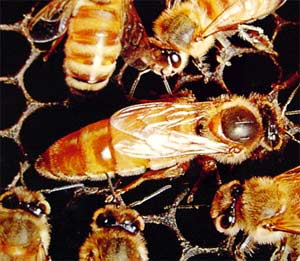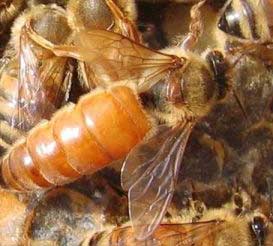Honey Bees

Queen Honey Bee
The Apis is the genus of bee called the honey bee. From Apis, we get the word apiculture – honey production, which is a practice that has taken place since prehistory. The honey bee is the bee that is the most famous and receives the most attention from our inquiring minds because we have been robbing them of their honey and wax for thousands of years.
Originally come from Asia, Africa and Europe, honey bees were later introduced to the Americas and Australia. There are currently 4-6 living species in this genus. They live in colonies with a queen. They are a sociable bee. There may be as 30,000 or more individuals in the colony with 95 percent being female worker bees. The males are called drones. The queen eats the royal jelly honey and the worker bees receive the standard issue worker jelly which has a lower percent of sugar. Worker bees are specialized in the type of work they do and there are many fields of work that a bee might enter into such as “attending the queen”, “shaping the comb”, “storing nectar”, and “foraging”.

Another Queen Bee
Unfortunately, it appears that honey bees are susceptible to different types of pollution and for this reason their numbers have been recently depleted in many regions around the world. The exact reason for their reduced numbers is not known. One likely cause of the trouble is pesticides used for farming. Although not intended for the bees, it is thought that these chemicals can attack the central nervous system of the bees causing all sorts of problems and making them more vulnerable to other ailments. The decline of the bee population does have negative effects for agriculture at large because while collecting pollen the bees carry and disperse pollen every which way pollinating flowers, fruit and vegetables. One single bee usually visits between 50-1000 flowers a day, but can visit up to several thousand!
